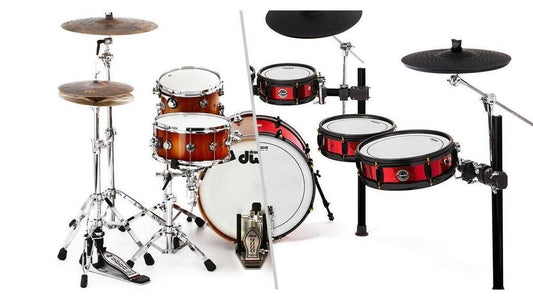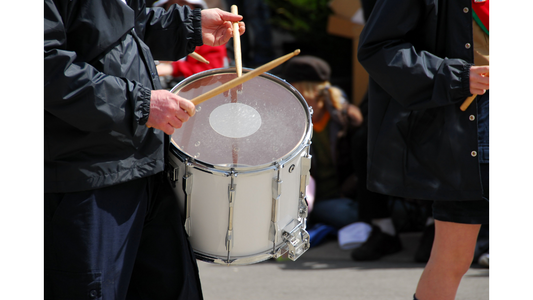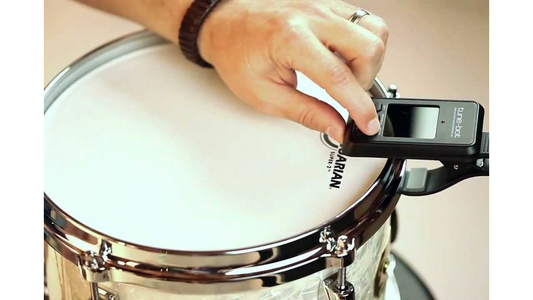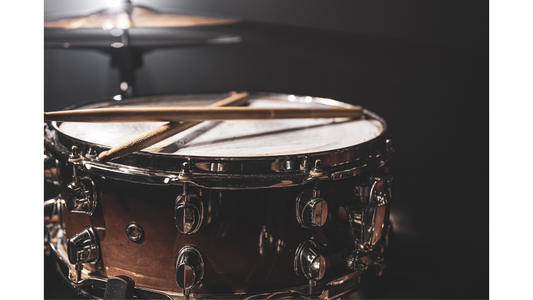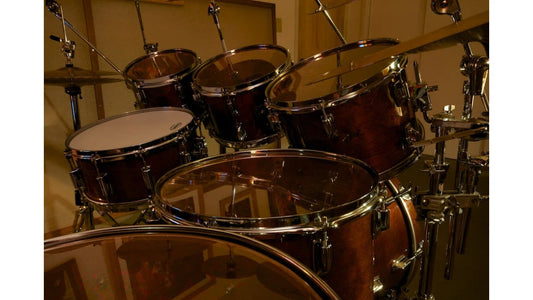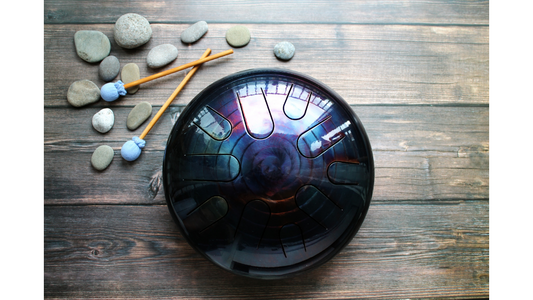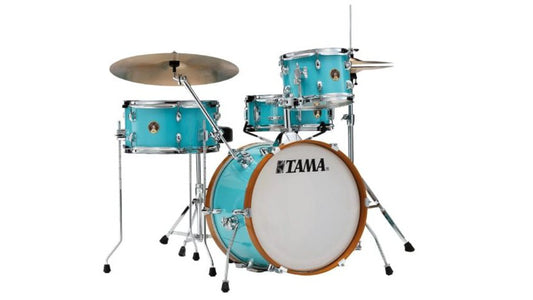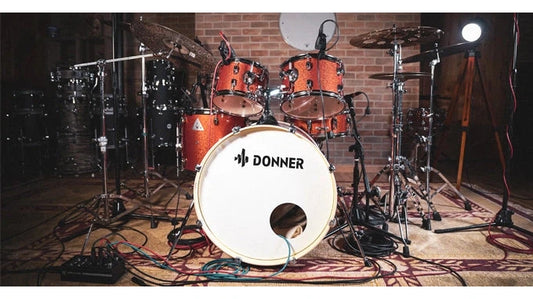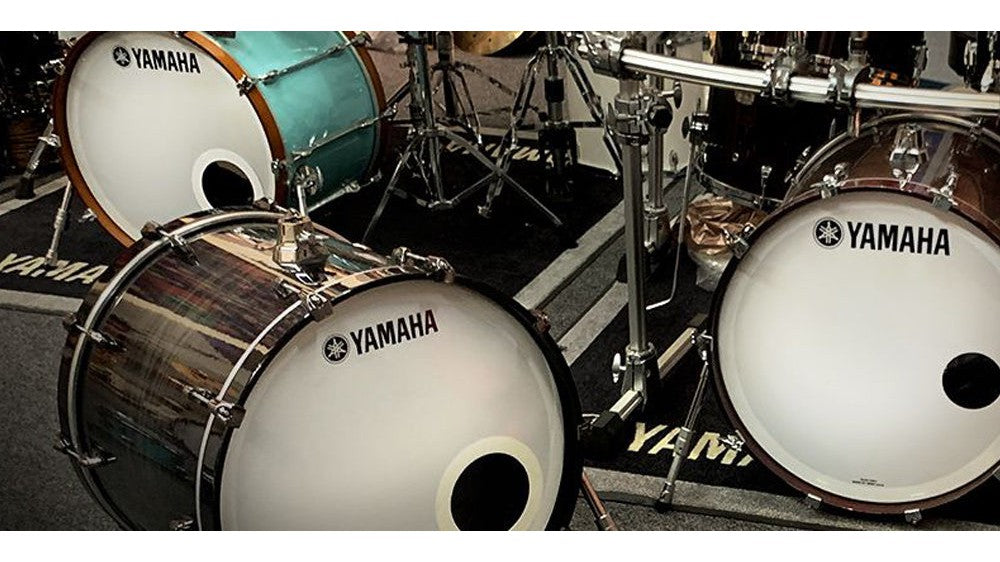
TRỐNG TOÀN TẬP - Phần 2: Trống Bass
Trong Trống Toàn Tập Phần 1, chúng ta đã tìm hiểu về các thông tin cần thiết về trống Snare và cách nó trở thành một phần quan trọng của âm nhạc đương đại. Trong phần 2 này, chúng ta sẽ nói về Trống Bass - Big Daddy của cả giàn trống.
Còn được gọi là trống “Kick”, trống Bass thường là trống lớn nhất và là trống duy nhất được chơi bằng bàn đạp chân. Nó thường được đặt trên sàn, mặt trước hướng về phía khán giả.

Trống Bass thường được đặt ở trung tâm giàn trống
Trống Bass được sử dụng trong hầu hết các phong cách âm nhạc, từ jazz và cổ điển đến death metal - mặc dù chúng được sử dụng khác nhau tùy thuộc vào thể loại. Trong âm nhạc đương đại, trống Bass và trống Snare là những thành phần quan trọng nhất của bộ trống. Trống Bass cung cấp “âm trầm” và thường được chơi ở các phách mạnh (phách 1 và 3) trong khi Snare được chơi ở phách nhẹ (phách 2 và 4). Trong nhạc jazz, trống Bass thường được chơi rất nhẹ để tạo ra một xung nhịp được cảm thấy nhiều hơn là nghe thấy, nhưng cũng được sử dụng để thả “bom” (giọng mạnh). Trong âm nhạc cổ điển, trống Bass cung cấp tiếng sấm mạnh mẽ, và các ban nhạc diễu hành sử dụng nó như một phương tiện thiết lập nhịp độ của cuộc hành quân.
LỊCH SỬ TRỐNG BASS
Trống Bass là hậu duệ của davul hoặc tabl turki (trống Thổ Nhĩ Kỳ) có từ những năm 1300, khiến nó trở thành một trong những nhạc cụ gõ lâu đời nhất. Davul là một trống hai đầu, căng dây, đường kính từ 60cm đến 70cm và được chơi bằng thanh gỗ hoặc bằng tay. Nó được sử dụng bởi các ban nhạc quân đội Ottoman, nhưng cũng là một phần quan trọng của âm nhạc phi quân sự ở khu vực đó trên thế giới.
Vào thế kỷ 18, quân đội Thổ Nhĩ Kỳ và các ban nhạc quân sự đã tiến vào châu Âu, nơi davul được đưa vào âm nhạc do Gluck, Mozart và Haydn viết. Cuối cùng, các nhà soạn nhạc như Berlioz và Verdi đã sử dụng trống Bass trong các tác phẩm của họ, và nó trở thành một phần quan trọng của bộ gõ dàn nhạc.
Vào đầu thế kỷ 20, việc phát minh ra bàn đạp chân (foot pedal) đã tạo ra một cuộc cách mạng trong nghệ thuật chơi trống bằng cách giúp một tay trống có thể chơi đồng thời trống Bass, trống Snare và Hi-hat. Ý tưởng về việc có một tay trống duy nhất trong một ban nhạc đã lan truyền từ thời đại Big Band và tiếp tục cho đến ngày nay - mặc dù đã có những ban nhạc nổi tiếng với hai tay trống chơi đồng thời các bộ dụng cụ riêng biệt.

Foot Pedal đã tạo ra một cuộc cách mạng trong nghệ thuật chơi trống
CÁC LOẠI GỖ LÀM TRỐNG BASS:
Vỏ trống Bass thường được làm từ nhiều loại gỗ như bạch dương, sồi hoặc phong (birch, oak hoặc maple). Chúng cũng có thể được làm từ sợi thủy tinh, thép không gỉ và acrylic, nhưng gỗ cho đến nay vẫn là vật liệu phổ biến nhất.
Bạch dương được sử dụng để sản xuất vỏ cho trống Yamaha Recording Custom và Stage Custom. Nó nhấn mạnh vào các tần số thấp và cao, mang lại âm thanh tươi sáng, sống động với các tần số trung bình giảm nhẹ. Bạch dương có khả năng trình diễn cao và kết hợp tốt với các nhạc cụ khác.
Gỗ Phong là một loại gỗ rất phổ biến để làm vỏ trống và được sử dụng trong các trống Yamaha Absolute Hybrid Maple và Tour Custom. Nó mang lại âm trầm ấm, tần số thấp và cao cân bằng, và tần số trung được tăng cường một chút. Vỏ của trống Yamaha Absolute Hybrid Maple sử dụng một lớp gỗ bên trong, một loại gỗ cứng và nặng kết hợp với gỗ thích để tạo ra âm thanh phong phú, rõ ràng ở tất cả các cấp độ động.
Gỗ sồi, được sử dụng trong trống Yamaha Live Custom Hybrid Oak, tạo ra âm tròn, âm cao êm dịu và âm thấp mở rộng, ấm áp với nhiều mức âm lượng. Live Custom Hybrid Oak được làm từ một miếng ghép bằng gỗ sồi bao quanh một lớp phenolic dày đặc - một thiết kế nhấn mạnh khả năng biểu diễn đồng thời tăng phạm vi động của trống. Ngoài ra, trọng lượng được đặt trong trống bass ở các điểm chốt (lug points) làm giảm tần số trung bình thấp để tạo ra âm thanh tập trung và chặt chẽ.
Vỏ trống Yamaha PHX ( Phoenix) được làm từ các loại gỗ jatoba, kapur và gỗ phong Bắc Mỹ. Cấu trúc độc đáo này tối đa hóa khả năng biểu diễn và tăng độ rung của đầu trống.
Không giống như các thanh đai chốt của trống Snare và trống Tom, các thanh đai chốt của trống Bass được làm từ gỗ và sử dụng "chốt xoay" để giữ vòng đeo vào trống. Các thanh đai được sử dụng với các chốt xoay này có thể có tay cầm chữ T để điều chỉnh dễ dàng .
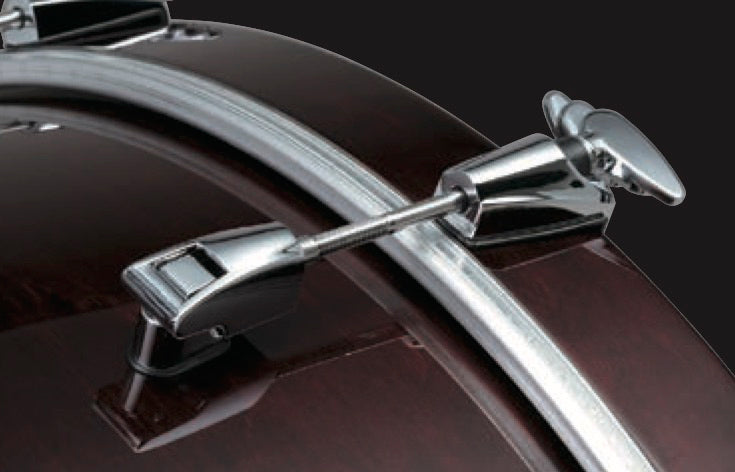
Thanh đai được sử dụng để giữ vòng gỗ trên trống Bass
CÁC KÍCH THƯỚC CỦA TRỐNG BASS:
Như bất kỳ loại trống nào khác, cao độ cơ bản của trống Bass được xác định bởi đường kính và độ sâu của vỏ: vỏ lớn hơn và sâu hơn thường tạo ra âm vực thấp hơn. Vỏ sâu hơn cũng cung cấp khả năng trình diễn tốt hơn, tạo ra nhiều âm bội hơn và thêm “bùng nổ” cho âm thanh. Nói chung, vỏ nông phản hồi nhanh hơn và có thể tạo ra âm thanh nhẹ hơn.
Trống Bass được thiết kế để sử dụng trong bộ trống có nhiều đường kính khác nhau, từ 18 đến 26 inch (từ 50cm cho tới 66 cm), với độ sâu trung bình từ 14 đến 18 inch (từ 35cm đến 45cm). Các trống Bass diễu hành có thể lớn hơn đáng kể và trống Bass trong một số bộ trống nhỏ gọn có độ sâu hẹp hơn. Ví dụ, trống Bass Yamaha Stage Custom Hip mới có độ sâu chỉ 8 inch (20cm), giúp vận chuyển dễ dàng hơn.

Trống Bass Yamaha Stage Custom Hip chỉ sâu 20cm
Đường kính vỏ tầm 45cm – 50cm là phổ biến cho nhạc jazz, trong khi đường kính 60cm – 70cm là tiêu chuẩn cho hầu hết các thể loại âm nhạc khác (m số tay trống chơi thể loại nhạc rock nặng thích trống Bass đường kính trên 70cm vì âm bass khủng). Sử dụng trống Bass có đường kính lớn có nghĩa là các Tom giá đỡ của bạn phải được đặt cao hơn, vì vậy hãy đảm bảo rằng bạn có thể có được các Tom ở nơi bạn muốn khi chọn kích thước trống Bass.
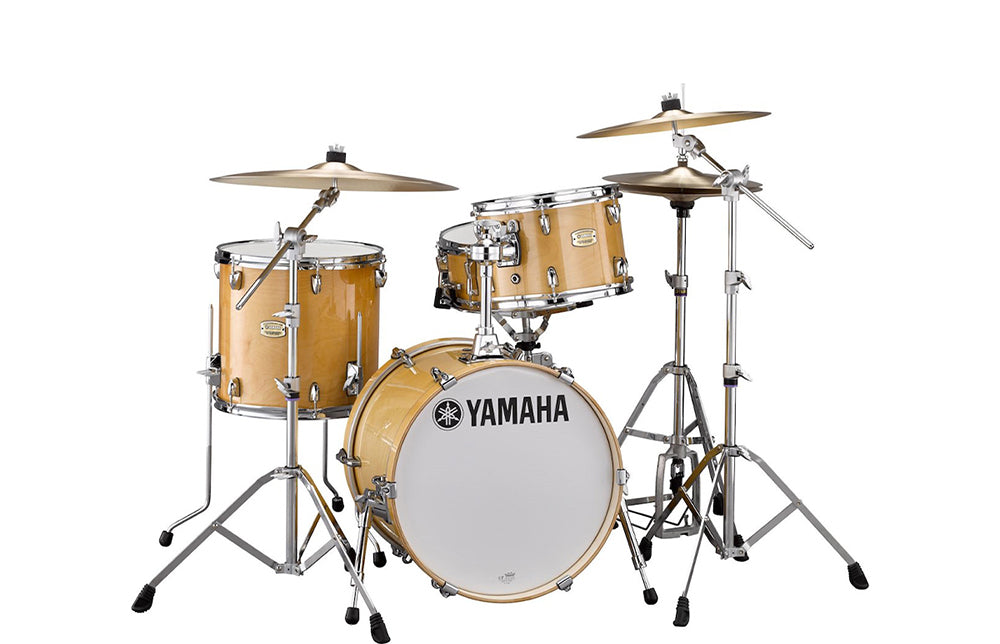
Yamaha Stage Custom Bop Kit bao gồm một trống Bass 45,7cm
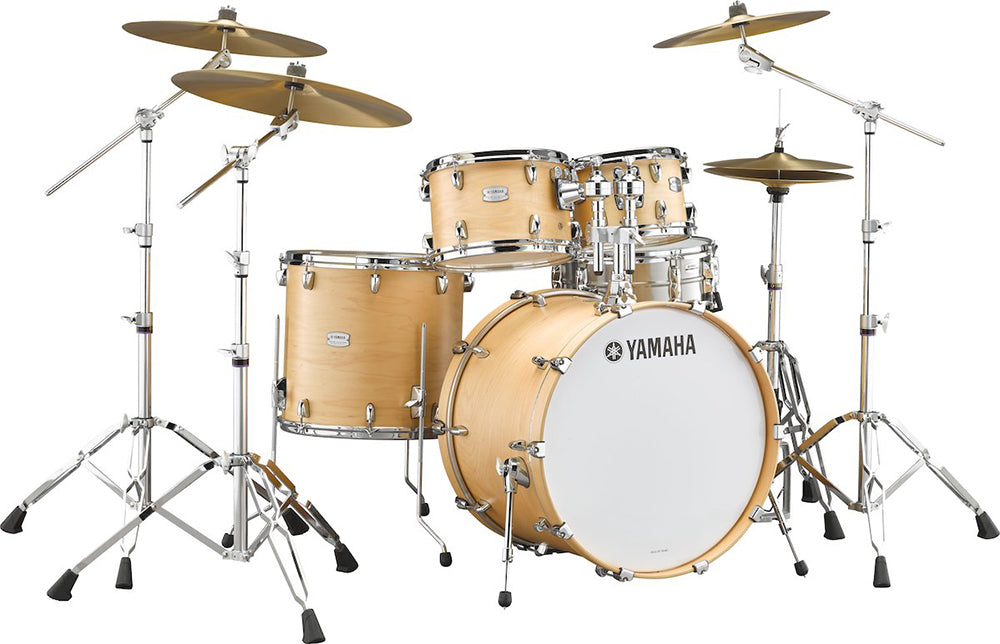
Yamaha Tour Custom
CỐ ĐỊNH TRỐNG BASS:
Ngoài các chốt, thanh đai hoặc vòng đai cố định, vỏ trống Bass thường có hardware (các giá đỡ kim loại) gắn lên. Chân hoặc “cựa” gắn vào mỗi bên của vỏ phục vụ mục đích ngăn trống lệch ra khỏi vị trí cố định. Một số chân trống Bass có các đầu mút có thể chuyển đổi: Chân đế cao su để sử dụng trên sàn cứng và chân đế có gai để sử dụng trên thảm.
Trống Bass cũng có công việc quan trọng là trụ cho các giá đỡ các trống Tom, vì vậy nhiều loại được trang bị giá đỡ gắn ở trên cùng của vỏ, chẳng hạn như các giá đỡ được sử dụng trên trống Yamaha Live Custom Hybrid Oak:
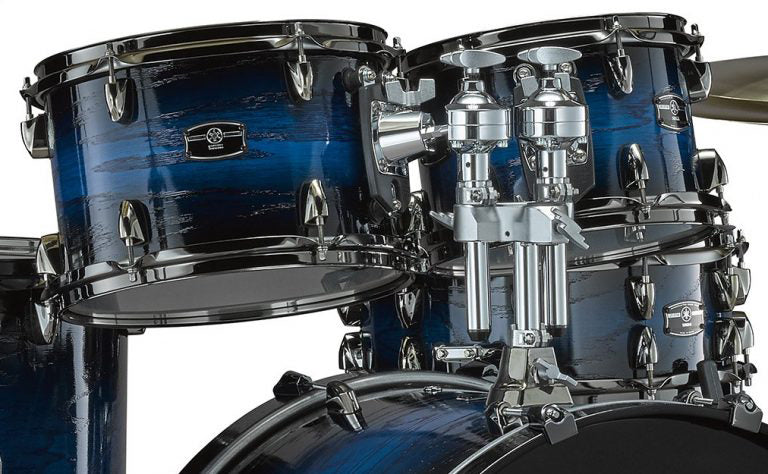
Giá đỡ ở đầu trống Bass hỗ trợ giá đỡ Tom hoặc Hi-hat
Những giá đỡ này thường đỡ cho một hoặc hai Tom, nhưng cũng có thể được sử dụng để gắn các giá đỡ Hi-hat. Giá đỡ Tom rất quan trọng vì đó là cách duy nhất để gắn hai Tom ở giữa trên trống Bass.
"KHOÉT LỖ TRÊN MẶT TRỐNG"
Nhiều tay trống thích khoét một lỗ ở mặt trước của trống Bass, điều này làm thay đổi tác động của âm thanh đồng thời giúp bạn dễ dàng đặt một miếng vải bên trong để làm giảm âm vang của trống. Lỗ này cũng tạo điều kiện thuận lợi cho việc đặt micrô và điều đó rất quan trọng trong các tình huống mà trống đang được ghi âm hoặc khuếch đại thông qua hệ thống PA. Tuy nhiên, những người chơi trống jazz thường thích giai điệu thuần khiết và thường không chọn lỗ hoặc bất kỳ sự giảm chấn nào bên trong trống.
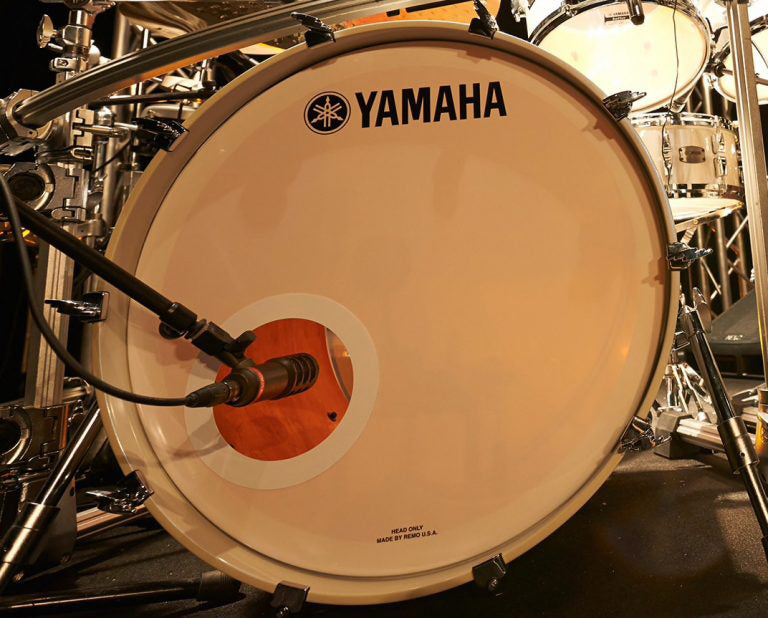
Một lỗ ở mặt trước của trống Bass giúp đặt mic dễ dàng.
Trống Bass là một phần quan trọng trong bộ trống của bạn cả về âm thanh và cách sắp xếp vật lý của bộ trống. Bạn nên dành nhiều thời gian nghiên cứu để đảm bảo mình chọn đúng phong cách mình thích.
Bài viết do VIỆT MUSIC biên soạn. Mọi sao chép cần được đồng ý bằng văn bản.
Tham khảo:
